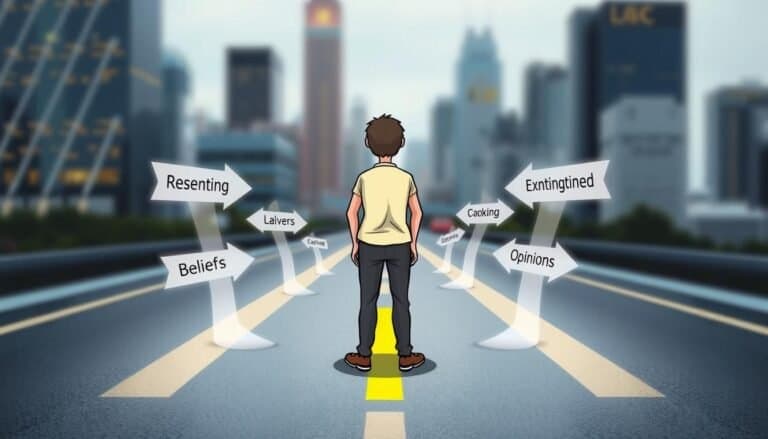Understanding The Mere Ownership Effect
Have you ever felt like something becomes more special just because you own it? This question leads us to the Mere Ownership Effect. It’s a fascinating psychological phenomenon that shows how we often see things more positively once they’re ours. This effect isn’t just about owning something legally or physically. Even just touching or imagining you own it can change how you see it.
We’re going to dive into this interesting topic. We’ll look at how owning something affects our choices, how we value things, and how it shapes marketing strategies.
Key Takeaways
- The Mere Ownership Effect makes us see owned items as more valuable.
- Just touching or imagining you own something can start this effect.
- This bias is connected to the endowment effect, showing how owning something changes our behavior.
- Attachment Theory and Self-referential Memory Theory help explain this phenomenon.
- We often like our own stuff more than the same items owned by others.
- Studies show the mere ownership effect works for both physical and intangible things.
- Owning something can influence our choices, affecting everything from personal likes to market trends.
Introduction to The Mere Ownership Effect
The Mere Ownership Effect is a fascinating way our minds work. It makes us think our stuff is more valuable than similar items we don’t own. This bias changes how we make decisions, affecting our choices in many areas.
Studies show just how big this effect is. In a study by Daniel Kahneman, Jack Knetsch, and Richard Thaler, people wanted more money for a mug than they first thought. This shows how owning something can change our view of its value.
Another study by Ziv Carmon and Dan Ariely found interesting results. People were willing to pay more for NCAA final four tickets than they would have before owning them. This shows how the Mere Ownership Effect works in everyday life and the economy.
Understanding The Mere Ownership Effect helps us see how our minds work. Research shows people work harder to keep bonuses they already have than ones they might get. This bias can help us in marketing, where how we see ownership affects what we buy.
Looking into The Mere Ownership Effect shows its big impact on our choices. Knowing about it can help make marketing better. It shows how making people feel like they own something can make them more engaged and happy with their purchases.
Definition and Characteristics of The Mere Ownership Effect
The Mere Ownership Effect is when people like things more because they own them. This is linked to ownership bias in behavioral economics. Owning something, real or not, makes it seem more valuable. Studies show that just touching an object makes people feel it’s theirs.
Touching an object can make people feel it’s theirs, whether they own it or not. Even imagining touching it can make them feel a strong sense of ownership. This shows how The Mere Ownership Effect works, making people value things more once they own them. This is true for many items like lottery tickets, mugs, pens, and chocolate bars.
How we feel about an item also changes when we touch it. If the touch feels good, we might think the item is worth more. This can change how much we value something and how we see it as our own. It shows how owning something changes our mind and affects how we act.
The Mere Ownership Effect does more than just change how we see things. It can make us feel better about ourselves and make us want to help others. Understanding this effect can change how we buy things and how we interact with others.
Psychological Theories Behind The Mere Ownership Effect
The mere ownership effect changes how people see and value their stuff. It’s about the emotional and memory ties we form with our things. Two main theories help us understand this: attachment theory and self-referential memory theory.
Attachment Theory
Attachment theory says owning things creates strong emotional bonds. This makes us see our stuff as more valuable. Studies show people who own something think it’s more attractive than those who don’t.
This fear of losing things makes us overvalue them. It shows how our personal feelings affect what we buy and how we see things.
Self-referential Memory Theory
Self-referential memory theory believes items linked to us are easier to remember and like. Just touching or thinking about owning something can make us value it more. Even a little bit of ownership can change how we see things.
This connection to ourselves makes us see our stuff in a better light. It shows that what we own is a part of who we are.
| Theoretical Concept | Description | Impact on Ownership |
|---|---|---|
| Attachment Theory | Emotional bonds with owned items | Increased perceived value and attraction |
| Self-referential Memory Theory | Better recall and appreciation of self-associated items | Enhanced evaluations and positive biases in judgment |
These theories help us understand why owning things affects us so much. They show how our feelings and memories shape our choices. Knowing this, businesses can make better marketing to connect with us.
Mere Ownership Effect vs. Endowment Effect
The mere ownership effect and the endowment effect show how owning something changes our decisions. The mere ownership effect makes us like what we own more. The endowment effect makes sellers want more money than buyers are willing to pay, often stopping deals.
Studies show big differences in how people value things. On average, buyers are only willing to pay half of what sellers want. Sellers are ready to accept $5.75, but buyers offer only $2.25. This shows how owning something changes its value in our eyes.
The endowment effect goes against the Coase Theorem, showing people don’t like fair deals. It’s because losing something hurts more than gaining something similar. People often think more highly of things they own than of things they don’t.
For example, those who owned a plastic drink insulator liked it more than those who didn’t.
Psychologists have studied these effects. In one study, many people didn’t want to switch jobs, even when it was better for them. This shows how strong feelings of ownership can affect our choices.
Even without owning something, people might think it’s more valuable. For instance, feeling like they own a chocolate bar made them rate it higher. Letting people touch products can make them value them more.
| Concept | Definition | Impact on Pricing |
|---|---|---|
| Mere Ownership Effect | Increases perceived value of owned items | Owners rate items more favorably, influencing higher pricing |
| Endowment Effect | Higher price demands from sellers compared to buyers’ offers | Significant price gaps due to ownership bias |
| Willingness to Pay (WTP) | Average amount buyers are willing to pay | $2.25 |
| Willingness to Accept (WTA) | Average amount sellers accept | $5.75 |
| Cognitive Psychology Findings | Behavioral patterns influenced by ownership perceptions | Impact on decisions in job changes, consumer purchases, etc. |
Examples of The Mere Ownership Effect in Everyday Life
The mere ownership effect shows up in many parts of our daily lives. It affects how we see and interact with things, from physical items to abstract ideas. This effect changes how we think and behave as consumers and how we see the world around us.
Physical Items
Studies have shown that owning something makes us value it more. For example, people like owning cars and collectibles more than not owning them. In experiments, people rated their own items almost twice as highly as items they didn’t own.
One interesting finding is about mugs. People who already had a mug were willing to pay more for another one. This shows how owning something makes us value it more, which is part of the mere ownership effect.
Abstract Concepts
The effect also reaches into abstract areas like beliefs and opinions. When people hold certain beliefs or political views, they see them as better than others do. This feeling of ownership makes them compare themselves to others in a way that boosts their own views.
This is important for understanding how people make choices and what they value. It shows how owning something changes how we see its worth.
| Category | Examples of Ownership | Impact on Valuation |
|---|---|---|
| Physical Items | Cars, Collectibles, Mugs | Rated higher by owners than non-owners |
| Abstract Concepts | Beliefs, Opinions, Political Stances | Owners view their ideas as more valuable |
These examples show how the mere ownership effect is everywhere in our lives. It affects how we act as consumers and shapes our views. Knowing this can help both consumers and marketers in their goals.
Influence of The Mere Ownership Effect on Decision Making
The Mere Ownership Effect changes how people see the value of things they own. It makes them think their items are worth more than they really are. This can lead to making choices based on feelings rather than facts, affecting how consumers behave.
Studies reveal that people see their own items as twice as valuable as the same items they don’t own. This boost in self-esteem from owning something can make people overvalue their possessions. They even prefer their items, even if they have flaws, showing how complex the link between owning and bias is.
Not every item is affected the same way by the ownership effect. The impact depends on the person and the type of item. This effect is strong for both physical goods and intangible beliefs.
For businesses, this knowledge is crucial. It helps them understand how customers might see products differently based on ownership and value. By using this insight, companies can improve the shopping experience. This leads to better choices during the buying process.
The Role of Cognitive Bias in The Mere Ownership Effect
The mere ownership effect shows how our minds play tricks on us, making us think our stuff is more valuable. We often think more highly of things we own than similar items we don’t have. This comes from our brains trying to make sense of things and our fear of losing what we have.
Research using brain scans has found certain areas light up when we look at our stuff. The parts of the brain that get busy include the ventromedial prefrontal cortex (vMPFC) and the medial orbitofrontal cortex (mOFC). These areas get more active when we think about things we own, especially when we feel good about ourselves.
But when we feel threatened, other brain areas kick in. These areas are linked to controlling our thoughts and feelings. This shows how our feelings and thoughts work together to make us value what we own more.
Knowing about these mental tricks is key for businesses. By understanding how our minds work, companies can make their products seem more valuable to us. This helps them use the mere ownership effect to their advantage.
| Cognitive Bias | Description | Impact on Ownership |
|---|---|---|
| Cognitive Dissonance | The mental discomfort experienced when one’s beliefs conflict with new information. | Increases the value placed on owned items as a way to alleviate discomfort. |
| Confirmation Bias | The tendency to search for, interpret, and remember information that confirms one’s preconceptions. | Leads individuals to favor positive information about their owned items while overlooking negatives. |
| Loss Aversion | The principle that losses weigh more heavily than equivalent gains in decision-making. | This bias pushes individuals to overvalue their possessions to avoid the pain of loss. |
Applications of The Mere Ownership Effect in Marketing Strategy
The Mere Ownership Effect is key in shaping marketing strategies. It helps us understand how people act and affects how we set prices. By using this effect, marketers can make products seem more valuable and set better prices.
Consumer Behavior Insights
People act differently because of the mere ownership effect. They often value things more if they own them. Studies show that owners are willing to accept more than buyers are willing to pay, often by a lot.
This knowledge helps marketers create strategies that connect with consumers on an emotional level. By making people feel like they already own a product, brands can make a stronger impact before a sale is made.
Impact on Pricing Strategies
Knowing how the mere ownership effect affects pricing is crucial for businesses. Buyers often focus on what they don’t like about products, while sellers highlight the good parts. This affects how people see prices.
For instance, changes in retail prices have a bigger impact on selling prices than buying prices. This means businesses need to think carefully about their pricing. Owners also think more about their possessions, which means prices should reflect this value.
| Factor | Owner Perspective | Non-Owner Perspective |
|---|---|---|
| Valuation Strength | Higher WTA, valuing ownership substantially more | Lower WTP, focusing on market prices |
| Cognitive Appraisal | Focus on positive attributes of owned products | Focus on undesirable features of potential purchases |
| Price Sensitivity | Less sensitivity to price changes | More sensitivity to pricing shifts |
Conclusion
The Mere Ownership Effect shows how people value things more if they own them. This idea affects how we make choices and what we prefer. It starts early, around two to three years old, when kids start liking their own things more.
This shows a deep bias in our thinking that stays with us as we grow up. It’s not just about kids; it’s a lifelong thing.
Studies show that owning something makes us think it’s better and more attractive. This difference in how we see things has big implications for marketing. Brands can use this to make their products seem more appealing.
Understanding how owning things affects us is key for businesses. Research on the Mere Ownership Effect helps create better marketing strategies. By knowing how owning things changes how we see them, brands can make their products more appealing to us.







